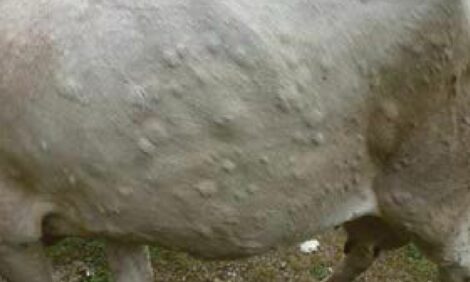



Australian Commodities Dairy Report
World dairy product prices recovered strongly in the first half of 2009-10 before partially retreating in early 2010, according to the Australian Commodities report from ABARE.
Stronger prices were the result of significantly higher import demand for milk powders by China and for butter by India in 2009, and lower than expected milk production in the European Union, Australia and New Zealand.
World dairy prices to rise in 2010-11
In 2010-11, world prices for most dairy products are forecast to rise, driven by increased demand for dairy products in developed and major dairy importing developing countries as world economic recovery strengthens. Although milk yields in 2010-11 are forecast to be higher, growth in milk production in the major producing countries is likely to be constrained, to some extent, by forecast lower cow herds, particularly in the European Union, the United States and Australia.
Medium-term outlook for world dairy prices
World prices for dairy products are projected to remain relatively high over the period to 2014-15. Compared with the average prices of the five years to 2006-07, world dairy product prices are projected to average around 25 per cent higher over the outlook period. Toward the end of the outlook period, projected higher dairy prices are expected to lead to increased milk production in the major exporting countries, placing downward pressure on world dairy prices.
Underpinning the medium-term price projections is the expected increase in demand for dairy products as a result of income and population growth as well as changing diets in favour of dairy products, particularly in developing countries.
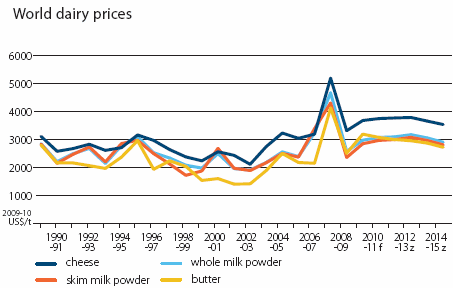
However, the characteristics of the world dairy market mean that international dairy prices are likely to continue to fluctuate significantly over the medium term. Only a relatively small share of world dairy production enters world trade and small changes in production or consumption of dairy products in the major dairying countries can lead to volatility in world dairy product prices. The disposal of intervention stocks, including through the use of export subsidies, may also contribute to significant fluctuations in world market prices.
World milk production to recover over the medium term
In 2010-11, milk production in most of the major producing and exporting countries is forecast to increase after the downturn in 2009-10.
In the European Union, milk output is forecast to rise marginally in 2010-11 as producers recover from the relatively low prices of 2009. However, EU milk production is still expected to be below the EU milk quota, which is due to be increased by a further 1 per cent for the 2010-11 marketing year.
US milk production is forecast to decline by around 0.5 per cent in 2010, which reflects an expected 2.2 per cent fall in the national cow herd because of the recent culling of dairy cows. Higher milk prices in 2010 and 2011 are expected to lead to increased feeding and higher milk yields.
New Zealand milk production is forecast to increase again in 2010-11 in line with longer term growth as producers respond to the improved profitability of dairying in that country. Australian milk production is forecast to decline by 5 per cent to 8.9 billion litres in 2009-10, which is the lowest production since 1997-98. Assuming favourable seasonal conditions, Australian milk production is forecast to recover in 2010-11 as producers respond to expected higher milk prices.
Over the medium term, global milk production is forecast to increase in the traditional dairy exporting countries as well as emerging countries in Asia, such as China and India, and in South America.
In the European Union, the total milk quota will increase by 1 per cent a year through to 2013-14 before the scheduled complete removal of production quotas from 2015. In 2008-09, milk production in the European Union was around 4 per cent below the milk quota and is expected to be below quota again in 2009-10. For EU countries where intensive grain feeding of dairy cows occurs, such as the Netherlands, projected relatively high grain prices over the medium term are expected to limit milk production increases. In contrast, EU countries with relatively low costs of production, such as Poland, will be less constrained. Overall, EU milk production is projected to increase over the medium term.
Following the sharp fall in world dairy product demand and world dairy prices in 2008-09, the US dairy industry implemented several dairy cow cull programs to reduce overcapacity in the industry. While the US dairy cow herd is projected to remain relatively stable over the medium term, continuing growth in milk yields is expected to lead to US milk production increasing by around 1 per cent annually over the outlook period.
Given the relatively favourable price outlook, New Zealand milk production is projected to increase by around 2 per cent annually, which is slightly less than the average growth rate experienced over the past 10 years. Much of the recent growth in milk production in New Zealand has resulted from an expansion in the number of dairy cows as agricultural land for other purposes was converted to dairying, particularly in the South Island. The extent to which further conversions take place over the medium term is likely to be limited by the availability of land that will generate higher returns to dairying relative to alternative uses. Therefore, further increases in milk production will depend on raising productivity.
Milk production in emerging economies
Milk production in most developing and emerging economies is characterised by relatively low milk yields. For example, milk yields in Brazil, an emerging dairy exporter, and India, the largest milk producing country, are low in comparison with the dairy industries in the United States and some countries of the European Union. The latter dairy industries are based on intensive grain feeding and this, combined with superior animal genetics, results in relatively high yields. Pasture based dairy industries of New Zealand, Argentina and, to a lesser extent, Australia also record lower average yields compared with the intensive feed based dairy industries operated in the United States and the European Union.

The Brazilian dairy industry is predominantly pasture based, with relatively low costs of milk production. Consequently, Brazil has the potential to be able to compete with other low cost producers, such as New Zealand and Australia, particularly in the market for milk powders. Over the medium term, Brazil’s milk production is projected to grow given the support it receives through interest rate subsidies and a minimum price program, and the potential to raise its productivity. However, much of the likely projected increase in Brazil’s milk production is expected to be used to meet the growing domestic demand for dairy products.
While Argentine milk production was adversely affected by drought in 2008-09, production is projected to increase over the medium term as efficiencies are gained through farm consolidations. Export taxes on dairy products were removed in March 2009 and this is expected to enhance Argentina’s export competitiveness.
Global demand and trade for dairy products to grow
Over the medium term, continuing economic growth in the major dairy importing regions, particularly developing countries, is expected to underpin import demand and lead to increased trade in dairy products.
Many Asian economies have reported substantial increases in animal protein consumption and in particular dairy products, although starting from a relatively low base. In general, demand for dairy products is responsive to rising incomes and many Asian countries have been experiencing westernisation of their diets. Urbanisation has also provided consumers with greater choice through the establishment of large retailers and restaurant chains. However, many Asian consumers are lactose intolerant and the consumption of fluid milk and milk fat is likely to remain lower than in other countries with comparable income characteristics. While many Asian countries provide some government support to their domestic dairy industries, most countries are expected to expand their dairy product imports over the outlook period.
Countries of North Africa and the Middle East are expected to remain significant importers of dairy products, particularly butter and milk powders. While some countries in the region, such as Algeria, are expected to increase milk production in response to increased government support, over the medium term the increase in production is unlikely to meet the expected growth in demand.
The Russian Federation is a large global importer of butter and cheese. However, there is some uncertainty over its import demand for dairy products over the medium term. The speed of economic recovery will influence domestic consumption and import demand for dairy products, particularly cheese. In recent years the government has introduced policies, such as subsidised credit for the construction of new dairies and higher import tariffs, to increase milk production. However, despite increased support the expected increase in production is unlikely to meet the growth in demand.
Cheese
Growth in global cheese consumption is expected to be underpinned by the recovery in economic growth in both developed and emerging economies. While Japan, the United States and the Russian Federation have been the most significant import markets for cheese, over the medium term the Republic of Korea, Mexico, South-East Asia, the Middle East and North Africa are expected to exhibit relatively strong growth in demand for cheese.Japan imports around 200 kilotonnes of cheese a year, which accounts for around 80 per cent of its domestic consumption. Over the medium term, growth in Japanese imports of cheese is likely to slow as a result of increased domestic production and the projected slow decline in the population. However, Japan is still expected to remain Australia’s largest cheese export market.
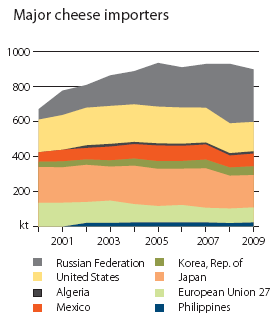
Cheese consumption in the Republic of Korea is expected to grow strongly over the medium term in response to greater exposure to western foods, such as pizza and pastas, and the associated rise in fast food outlets. Demand for imported premium soft cheeses, such as Brie and Camembert, is growing as consumers are offered greater choice. Elsewhere in Asia, while per person consumption remains low there is expected to be a continued change in diets to include more dairy products, particularly cheese.
World cheese prices are forecast to increase by three per cent to US$3800 a tonne in 2010-11, as compared to the forecast increase of 12 per cent in 2009-10.
Butter
The key global markets for butter and butter oil include the Russian Federation, the Middle East, North Africa and Asia. World demand for butter is expected to improve in 2010-11 as economic activity in the main importing regions strengthens. While the Russian Federation is expected to remain the dominant importer of butter over the medium term, additional imports are expected by Mexico and some South- East Asian countries, such as Vietnam.
World butter prices are forecast to decline slightly to US$3120 a tonne in 2010-11, having been forecast to increase by 28 per cent for the current year. Over the medium term, world butter prices are projected to decline, in real terms, reaching US$2718 a tonne (in 2009-10 dollars) by 2014-15. This reflects higher supplies in the major exporting countries. A key uncertainty for prices in the short term is the timing of the disposal of EU intervention stocks onto the world market. EU butter stocks were 76 353 tonnes at the beginning of 2010. However, a significant proportion of these stocks have been allocated for distribution by charitable organisations to persons in need within the European Union in the second half of 2010.
Milk powders
Global trade in whole milk powder is dominated by New Zealand. Exports of whole milk powder from New Zealand have increased by 7 per cent annually since 2005. Other major suppliers are the European Union, Argentina and Australia. With EU milk production projected to increase only slightly over the medium term and EU cheese production to continue to rise, growth in EU exports of whole milk powder is expected to be relatively limited over the projection period. With forecast higher milk production in South America, both Argentina and Brazil are also projected to increase their exports of whole milk powder over the outlook period.
Over the medium term, China is likely to remain an opportunistic buyer of milk powders on the world market. In 2009, Chinese imports of whole milk powder increased fourfold to reach 165 kilotonnes. The Chinese melamine contamination in 2008 undermined consumer confidence in domestically produced dairy products and, as a consequence, milk production in China declined sharply in 2009. Further sales of contaminated product were reported in early 2010 and this has the potential to again affect demand for domestically produced milk powders in favour of imports.
Per person consumption of dairy products remains relatively low in China, but over the medium term consumption is expected to grow as incomes increase and continued urbanisation takes place. Chinese milk production has increased significantly over the past decade and, although falling in 2009, production is expected to resume its longer term growth rate over the medium term, in line with greater investment in production and processing facilities.
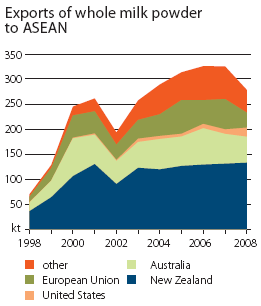
South-East Asia is the largest importer of milk powders and is the principal destination for Australian exports. However, Australian milk powder exporters are expected to face increased competition over the medium term from other low cost suppliers such as Brazil, Argentina and New Zealand. An expected recovery in US dairy production in the second half of the projection period could also result in higher US skim milk powder exports to this region.
World whole milk powder prices are forecast to remain relatively high averaging US$3111 a tonne, in 2009-10 dollars, over the next three years and around 21 per cent higher than the average price achieved in 2008-09. Toward the end of the projection period, increased supplies of whole milk powder are expected to moderate real prices, with prices projected to be US$2899 a tonne in 2014-15.
Similarly, world skim milk powder prices are forecast to rise to an average of US$3012 a tonne, in 2009-10 dollars, over the next three years before increased world exports, particularly from the United States and New Zealand, are expected to put downward pressure on prices toward the end of the outlook period. The timing of the eventual disposal of skim milk powder stocks from EU intervention stores onto the world is uncertain. At the beginning of January 2010, EU intervention stocks of skim milk powder were 257 788 tonnes. From this, 65 290 tonnes will be distributed within the European Union by charitable organisations to persons in need.
Prospects for Australian dairy products
While world dairy product prices in 2010-11 are forecast to remain close to the average prices of the previous year, the forecast relatively high Australian dollar is likely to continue to temper the returns to Australian dairy exporters. Overall, the Australian farm-gate price for milk is forecast to average 35.5 cents a litre in 2010-11, which is only slightly higher than the current year.
Average farm-gate prices for milk are projected to rise to 2014-15, peaking at 36.3 cents a litre (in 2009-10 dollars) in 2013-14. At the end of the outlook period, Australian farm-gate prices are expected to ease back slightly, which reflects projected weaker international prices.
Australian milk production to recover over the medium term
Australian milk production is forecast to decline by around five per cent to 8930 million litres in 2009-10. Most of this forecast fall in production is expected to occur in Victoria and Tasmania where dairy farmers are more focused on producing manufacturing milk and thereby more exposed to fluctuations in returns from dairy export markets. Milk production is expected to fall sharply in the irrigation areas of northern Victoria where many farmers have culled their herds and adjusted their feeding regimes in response to the sharp decline in farm-gate milk prices in the first half of 2009.
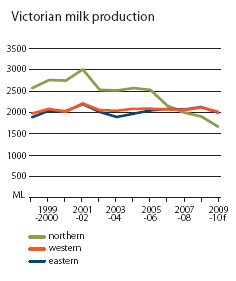
Assuming favourable seasonal conditions, Australian milk production is forecast to increase slightly in 2010-11, but remain below that of recent years. Over the medium term, milk production is projected to rise gradually to reach 9.7 billion litres in 2014-15, driven largely by productivity increases.
Milk production over the medium term will depend on seasonal conditions, water availability in the main irrigation areas and fodder prices. The availability of water for irrigation, particularly in northern Victoria and southern New South Wales, is likely to be a continuing constraint on milk production in these areas, as competing water demands from urban users and the environment need to be balanced.
Many farmers in these irrigation areas have developed management strategies to cope with reduced water allocations—some of these have involved increasing supplementary feeding, particularly of grain. Supplementary feed now accounts for around one-third of farm cash costs of dairy farms. While domestic grain prices are forecast to be lower in 2010-11, grain prices (in 2009-10 dollars) are projected to remain relatively high over the medium term.
Climate variability will continue to be a key issue for the Australian dairy industry. For example, should they occur again, the extended periods of well above average temperatures during the peak milk production months, particularly in south-eastern Australia, will adversely affect milk yields and thereby constrain growth in milk production.
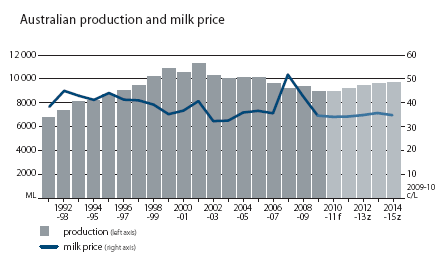
Over the outlook period, changes in Australia’s dairy product mix and total output will be driven by changes in relative returns from the various manufactured products. For example, the relative prices for higher valued products such as cheese are projected to be higher than prices of other dairy products. As a result, cheese is likely to account for an increased proportion of manufactured dairy product output and Australian dairy exports over the outlook period.
Australian domestic market
In 2008-09, around 55 per cent of Australia’s milk production was sold on the domestic market—the highest proportion since the mid-1990s—which reflects the decline in milk production since the early 2000s. Over the medium term, the domestic market is expected to remain the dominant outlet for many of Australia’s dairy products. At the same time, imports of cheese and, to a lesser extent, butter are expected to continue to grow.
Around one-quarter of Australia’s milk production is sold as market milk. Since 2000-01, market milk sales have increased by 16 per cent to reach 2244 million litres in 2008-09. According to Dairy Australia, market milk consumption has been steadily shifting from regular milk to modified milk types, such as reduced and low fat milks. Total consumption of market milk is forecast to increase over the outlook period in line with income and population growth as well as demographic and lifestyle changes.
While per person consumption of cheese has been relatively stable in recent years there has been a shift from cheddar to non-cheddar varieties, except in 2008-09 when this trend was reversed. The consumption of fresh and frozen dairy products, such as yoghurts, dairy desserts and ice cream, have expanded in the past decade and are expected to continue to increase over the outlook period.
Australian dairy exports
The total value of Australian dairy exports is forecast to increase by seven per cent to $2 billion in 2010-11. Over the medium term, the total value of Australian dairy exports is projected to remain around $2 billion (in 2009-10 dollars) in 2014-15, which reflects relatively lower projected world dairy product prices toward the end of the outlook period.
| . | unit | 2007-08 | 2008-09 | 2009-10f | 2010-11f | 2011-12z | 2012-13z | 2013-14z | 2014-15z |
|---|---|---|---|---|---|---|---|---|---|
|
World
|
|||||||||
|
Indicative price
|
|||||||||
|
Butter
|
|||||||||
| – nominal | US$/t | 4 027 | 2 485 | 3 188 | 3 120 | 3 100 | 3 120 | 3 100 | 3 000 |
| – real a | US$/t | 4 121 | 2 508 | 3 188 | 3 076 | 2 995 | 2 952 | 2 870 | 2 718 |
| – real a | US$/t | 4 121 | 2 508 | 3 188 | 3 076 | 2 995 | 2 952 | 2 870 | 2 718 |
|
Skim milk powder
|
|||||||||
| – nominal | US$/t | 4 204 | 2 333 | 2 846 | 3 010 | 3 100 | 3 250 | 3 200 | 3 100 |
| – real a | US$/t | 4 302 | 2 355 | 2 846 | 2 967 | 2 995 | 3 075 | 2 963 | 2 808 |
|
Cheese
|
|||||||||
| – nominal | US$/t | 5 073 | 3 281 | 3 677 | 3 800 | 3 900 | 4 000 | 3 950 | 3 900 |
| – real a | US$/t | 5 191 | 3 311 | 3 677 | 3 746 | 3 768 | 3 785 | 3 657 | 3 533 |
|
Australia
|
|||||||||
| Cow numbers b | ’000 | 1 640 | 1 645 | 1 567 | 1 580 | 1 605 | 1 615 | 1 610 | 1 610 |
| Yield per cow | L | 5 624 | 5 707 | 5 699 | 5 715 | 5 789 | 5 882 | 5 969 | 6 025 |
| Yield per cow | L | 5 624 | 5 707 | 5 699 | 5 715 | 5 789 | 5 882 | 5 969 | 6 025 |
|
Production
|
|||||||||
| Total milk | ML | 9 223 | 9 388 | 8 930 | 9 030 | 9 290 | 9 500 | 9 610 | 9 700 |
| Total milk | ML | 9 223 | 9 388 | 8 930 | 9 030 | 9 290 | 9 500 | 9 610 | 9 700 |
| – Market sales | ML | 2 202 | 2 244 | 2 282 | 2 310 | 2 365 | 2 410 | 2 445 | 2 490 |
| – Market sales | ML | 2 202 | 2 244 | 2 282 | 2 310 | 2 365 | 2 410 | 2 445 | 2 490 |
| Manufacturing | ML | 7 021 | 7 144 | 6 648 | 6 720 | 6 925 | 7 090 | 7 165 | 7 210 |
| Butter c | kt | 128 | 148 | 130 | 125 | 120 | 112 | 115 | 110 |
| Cheese | kt | 361 | 342 | 321 | 319 | 335 | 348 | 354 | 352 |
| Skim milk powder | kt | 164 | 212 | 198 | 195 | 190 | 184 | 183 | 183 |
| Wholemilk powder | kt | 164 | 212 | 198 | 195 | 190 | 184 | 183 | 183 |
|
Farmgate milk price d
|
|||||||||
| – nominal | Ac/L | 49.6 | 42.5 | 35.2 | 35.5 | 36.5 | 38.0 | 40.0 | 40.0 |
| – real e | Ac/L | 52.4 | 43.5 | 35.2 | 34.7 | 34.8 | 35.4 | 36.3 | 35.4 |
|
Export volume
|
|||||||||
| Butter c | kt | 57 | 70 | 73 | 62 | 52 | 46 | 46 | 44 |
| Cheese | kt | 203 | 146 | 130 | 131 | 137 | 148 | 153 | 149 |
| Skim milk powder | kt | 123 | 162 | 153 | 151 | 142 | 131 | 133 | 132 |
| Wholemilk powder | kt | 82 | 116 | 97 | 99 | 103 | 106 | 106 | 104 |
|
Export value
|
|||||||||
| – nominal | A$m | 2 763 | 2 679 | 1 894 | 2 029 | 2 135 | 2 263 | 2 329 | 2 282 |
| – real e | A$m | 2 916 | 2 742 | 1 894 | 1 983 | 2 036 | 2 106 | 2 114 | 2 021 |
March 2010
| TheCattleSite News Desk |


